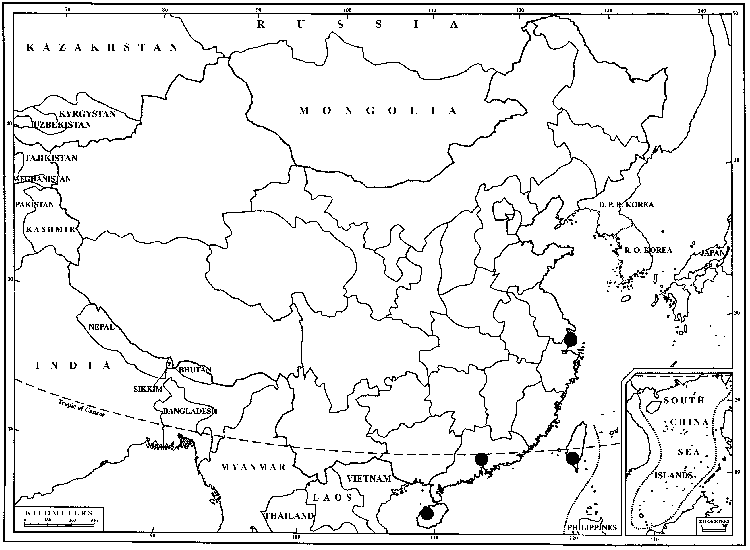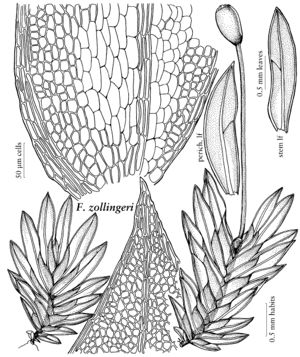Fissidens zollingeri
Ann. Sci. Nat., Bot., sér. 3, 4: 114. 1845,.
Plants to 5.5 × 3.0 mm. Stem unbranched and branched; axillary hyaline nodules absent; central strand weak or absent. Leaves as many as 12 pairs, lanceolate to oblong-lanceolate, rarely linear-lanceolate, acute or infrequently obtuse, to 2.5 × 0.5 mm; dorsal lamina narrowed proximally, ending at insertion, not decurrent; vaginant laminae ± 1/2 leaf length, equal; margin entire but serrulate distally, limbate on all laminae, limbidium confluent at apex or ending slightly before, limbidial cells 1-stratose or 2-stratose; costa percurrent to short-excurrent, bryoides-type; laminal cells 1-stratose, distinct, smooth, slightly bulging, firm-walled, irregularly hexagonal, 6.5–18 µm, greatly enlarged, ± oblong, ± pellucid in juxtacostal patches in proximal portions of vaginant laminae. Sexual condition rhizautoicous and synoicous. Sporophytes 1–2 per perichaetium. Capsule theca erect, radially symmetric to slightly arcuate, bilaterally symmetric, 0.5–0.8 mm; peristome scariosus-type; operculum to 0.8 mm. Calyptra cucullate, smooth, 0.6 mm. Spores 10–13 µm.
Habitat: Damp calcareous soil and limestone rocks in ravines and woods
Distribution

Ala., Fla., Ga., La., Miss., Mexico, West Indies, Central America, South America, Asia, Africa
Discussion
Fissidens zollingeri is best distinguished by its usually palmately arranged leaves, limbidium present on all laminae of the leaf, and juxtacostal patches of enlarged, oblong, pellucid cells in the proximal parts of the vaginant laminae. The distal laminal cells are distinct, smooth, and slightly bulging. It is closely related to two other tropical species, F. angustifolius Sullivant and F. yucatanensis Steere, both of which have limbate leaves and groups of enlarged, pellucid cells in the proximal parts of the vaginant laminae. The distal laminal cells of those species, however, are mammillose. Axillary, stalked, multicellular, clavate gemmae have been observed in tropical specimens of F. zollingeri.
Selected References
None.
Lower Taxa
No values specified."/2" is not declared as a valid unit of measurement for this property.
